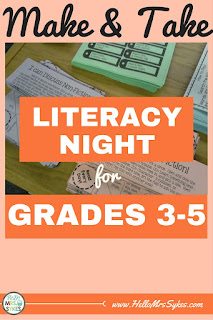Practicing Fluency and Comprehension - Close Reads
In my experiences as a literacy coach, classroom teacher, and literacy specialist, I noticed that my upper elementary kiddos who struggle with reading usually have some similarities. They are typically not fluent readers, and they rely on prior knowledge instead of the information they read. Not all struggling readers have these issues, naturally. :)
When I say fluency, I know the picture that pops into the head of many teachers... anxious students, stopwatches, and lists of nonsense words while you tell the kiddos to read as fast as they can! That's not what I mean. I'm not talking about their oral reading fluency - I'm concerned that these kiddos who struggle with reading aren't fluent readers when they read to themselves. Since the best way to become a better reader is to read, and they struggle reading, then reading isn't usually something they are clamoring to do.
For months, I have been inspired to create "Practicing Fluency and Comprehension" articles to address the issues of fluency, close reading, and referring to text that many upper elementary students struggle with during reading.
Right now, I have 2 of these... one is on Forces and Motion at the amusement park, and the other is on Winter Sports that traditionally are included in the Olympics.
Here's how I use it:
* Project the article and preview the text together. Look at the title, graphics, captions, and read the directions.
* Students read the article 3 times to themselves or with a partner, if needed.
* The graphic organizer can be used during the 3 fluency readings (add a bit each time), as a small group activity to facilitate discussion of the text, or as an independent activity.
* Students are required to annotate text as they answer questions.
* During group discussions, project the passage for easy sharing of evidence.
Love it! Now that I've taught them the procedure for tackling the articles, they are reading closely, making connections between what they already knew and what the text says, referring to evidence, and seeing themselves as readers. :)

When I say fluency, I know the picture that pops into the head of many teachers... anxious students, stopwatches, and lists of nonsense words while you tell the kiddos to read as fast as they can! That's not what I mean. I'm not talking about their oral reading fluency - I'm concerned that these kiddos who struggle with reading aren't fluent readers when they read to themselves. Since the best way to become a better reader is to read, and they struggle reading, then reading isn't usually something they are clamoring to do.
For months, I have been inspired to create "Practicing Fluency and Comprehension" articles to address the issues of fluency, close reading, and referring to text that many upper elementary students struggle with during reading.
 |
| (On Teachers Pay Teachers) |
 |
| (On Teachers Pay Teachers) |
I'm really pleased with this packet, and have enjoyed using it to incorporate interesting and relevant content in a short, focused, and easy-to-demonstrate format that helps build stronger readers in upper elementary. It's pretty short and sweet - a collection of original articles about the topic (each has 3 text-dependent questions), 3 stars on the page (for students to shade in each time they read the passage to encourage repeated readings), and a text-specific graphic organizer.
 |
| (Forces and Motion) |
* Project the article and preview the text together. Look at the title, graphics, captions, and read the directions.
* Students read the article 3 times to themselves or with a partner, if needed.
* The graphic organizer can be used during the 3 fluency readings (add a bit each time), as a small group activity to facilitate discussion of the text, or as an independent activity.
* Students are required to annotate text as they answer questions.
* During group discussions, project the passage for easy sharing of evidence.





Comments
Post a Comment
I love to hear from you. Thanks for supporting my tiny corner of the internet.